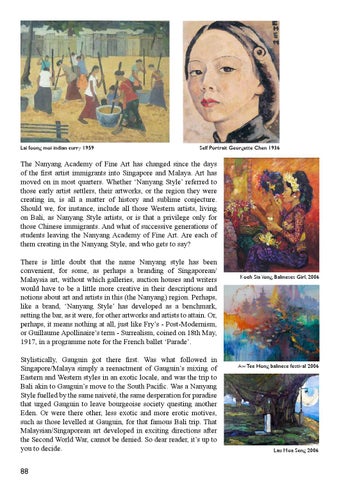Lai foong moi indian curry 1959
Self Portrait Georgette Chen 1936
The Nanyang Academy of Fine Art has changed since the days of the first artist immigrants into Singapore and Malaya. Art has moved on in most quarters. Whether ‘Nanyang Style’ referred to those early artist settlers, their artworks, or the region they were creating in, is all a matter of history and sublime conjecture. Should we, for instance, include all those Western artists, living on Bali, as Nanyang Style artists, or is that a privilege only for those Chinese immigrants. And what of successive generations of students leaving the Nanyang Academy of Fine Art. Are each of them creating in the Nanyang Style, and who gets to say? There is little doubt that the name Nanyang style has been convenient, for some, as perhaps a branding of Singaporean/ Malaysia art, without which galleries, auction houses and writers would have to be a little more creative in their descriptions and notions about art and artists in this (the Nanyang) region. Perhaps, like a brand, ‘Nanyang Style’ has developed as a benchmark, setting the bar, as it were, for other artworks and artists to attain. Or, perhaps, it means nothing at all, just like Fry’s - Post-Modernism, or Guillaume Apollinaire’s term - Surrealism, coined on 18th May, 1917, in a programme note for the French ballet ‘Parade’. Stylistically, Gauguin got there first. Was what followed in Singapore/Malaya simply a reenactment of Gauguin’s mixing of Eastern and Western styles in an exotic locale, and was the trip to Bali akin to Gauguin’s move to the South Pacific. Was a Nanyang Style fuelled by the same naiveté, the same desperation for paradise that urged Gauguin to leave bourgeoise society questing another Eden. Or were there other, less exotic and more erotic motives, such as those levelled at Gauguin, for that famous Bali trip. That Malaysian/Singaporean art developed in exciting directions after the Second World War, cannot be denied. So dear reader, it’s up to you to decide.
88
Koeh Sia Yong, Balineses Girl, 2006
Aw Tee Hong balinese festival 2006
Lau Moa Seng 2006
